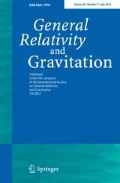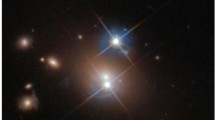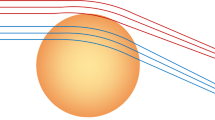Abstract
The mathematical theory of gravitational lensing has revealed many generic and global properties. Beginning with multiple imaging, we review Morse-theoretic image counting formulas and lower bound results, and complex-algebraic upper bounds in the case of single and multiple lens planes. We discuss recent advances in the mathematics of stochastic lensing, discussing a general formula for the global expected number of minimum lensed images as well as asymptotic formulas for the probability densities of the microlensing random time delay functions, random lensing maps, and random shear, and an asymptotic expression for the global expected number of micro-minima. Multiple imaging in optical geometry and a spacetime setting are treated. We review global magnification relation results for model-dependent scenarios and cover recent developments on universal local magnification relations for higher order caustics.
Similar content being viewed by others
References
Aazami A.B., Petters A.O.: A universal magnification theorem for higher-order caustic singularities. J. Math. Phys. 50, 032501 (2009)
Aazami A.B., Petters A.O.: A universal magnification theorem II. Generic caustics up to codimension five. J. Math. Phys. 50, 082501 (2009)
Aazami, A.B., Petters, A.O.: A universal magnification theorem III. Caustics beyond codimension five. J. Math. Phys. (2009), math-ph/0909.5235 (to appear)
Abramowicz M.A., Carter B., Lasota J.P.: Optical reference geometry for stationary and static dynamics. Gen. Relativ. Gravit. 20, 1173 (1988)
Adler R., Taylor J.: Random Fields and Geometry. Wiley, London (1981)
Arnold V.I.: Normal forms for functions near degenerate critical points, the Weyl groups of A k , D k , E k and Lagrangian singularities. Func. Anal. Appl. 6, 254 (1973)
Arnold V.I.: Evolution of singularities of potential flows in collision-free media and the metamorphoses of caustics in three-dimensional space. J. Sov. Math. 32, 229 (1986)
Arnold V.I., Gusein-Zade S.M., Varchenko A.N.: Singularities of Differentiable Maps, vol. 1. Birkhäuser, Boston (1985)
Arnold V.I., Gusein-Zade S.M., Varchenko A.N.: Singularities of Differentiable Maps, vol. 2. Birkhäuser, Boston (1985)
Atiyah M.F., Bott R.: A Lefschetz fixed point formula for elliptic complexes: I. Appl. Ann. Math. 86, 374 (1967)
Atiyah M.F., Bott R.: A Lefschetz fixed point formula for elliptic complexes: II. Appl. Ann. Math. 88, 451 (1968)
Azais J.M., Wschebor M.: On the distribution of the maximum of a Gaussian field with d parameters. Ann. Appl. Probab. 15(1A), 254 (2005)
Bayer J., Dyer C.C.: Maximal lensing: mass constraints on point lens configurations. Gen. Relativ. Gravit. 39, 1413 (2007)
Blandford R.D.: Gravitational lenses. Q. J. R. Astron. Soc. 31, 305 (1990)
Blandford R., Narayan R.: Fermat’s principle, caustics, and the classification of gravitational lens images. Astrophys. J. 310, 568 (1986)
Burke W.: Multiple gravitational imaging by distributed masses. Astrophys. J. Lett. 244, L1 (1981)
Castrigiano D., Hayes S.: Catastrophe Theory. Addison-Wesley, Reading (2004)
Chiba M.: Probing dark matter substructure in lens galaxies. Astrophys. J. 565, 17 (2002)
Dalal N.: The magnification invariant of simple galaxy lens models. Astrophys. J. 509, 13 (1998)
Dalal N., Rabin J.M.: Magnification relations in gravitational lensing via multidimensional residue integrals. J. Math. Phys. 42, 1818 (2001)
Ehlers J., Newman E.T.: The theory of caustics and wave front singularities with physical applications. J. Math. Phys. 41, 3344 (2000)
Evans N.W., Hunter C.: Lensing properties of cored galaxy models. Astrophys. J. 575, 68 (2002)
Evans N.W., Witt H.J.: Are there sextuplet and octuplet image systems?. Mon. Not. R. Astron. Soc. 327, 1260 (2001)
Frankel T.: Gravitational Curvature: An Introduction to Einstein’s Theory. W. H. Freeman, San Francisco (1979)
Friedrich H., Stewart M.J.: Characteristic initial data and wavefront singularities in general relativity. Proc. R. Soc. Lond. A 385, 345 (1983)
Forrester P.J., Honner G.: Exact statistical properties of the zeros of complex random polynomials. J. Phys. A Math. Gen. 32, 2961 (1999)
Giannoni F., Lombardi M.: Gravitational lenses: odd or even images?. Class. Quantum Grav. 16, 1 (1999)
Giannoni F., Masiello A., Piccione P.: A Morse theory for light rays on stably causal Lorentzian manifolds. Ann. Inst. H. Poincaré Phys. Theor. 69, 359 (1998)
Gibbons G.W.: No glory in cosmic string theory. Phys. Lett. B 308, 237 (1993)
Gibbons G.W., Herdeiro C.A.R., Warnick C., Werner M.C.: Stationary metrics and optical Zermelo–Randers–Finsler geometry. Phys. Rev. D 79, 044022 (2009)
Gibbons G.W., Warnick C.M.: Universal properties of the near-horizon optical geometry. Phys. Rev. D 79, 064031 (2009)
Gibbons G.W., Werner M.C.: Applications of the Gauss–Bonnet theorem to gravitational lensing. Class. Quantum Grav. 25, 235009 (2008)
Gilmore R.: Catastrophe Theory for Scientists and Engineers. Dover, New York (1981)
Golubitsky M., Guillemin V.: Stable Mappings and Their Singularities. Springer, Berlin (1973)
Gottlieb D.H.: A gravitational lens need not produce an odd number of images. J. Math. Phys. 35, 5507 (1994)
Granot J., Schechter P.L., Wambsganss J.: The mean number of extra microimage pairs for macrolensed quasars. Astrophys. J. 583, 575 (2003)
Griffiths P., Harris J.: Principles of Algebraic Geometry. Wiley, New York (1994)
Hunter C., Evans N.W.: Lensing properties of scale-free galaxies. Astrophys. J. 554, 1227 (2001)
Katz N., Balbus S., Paczyński B.: Random scattering approach to gravitational microlensing. Astrophys. J. 306, 2 (1986)
Keeton, C.R.: Gravitational lensing with stochastic substructure: Effects of the clump mass function and spatial distribution. http://xxx.lanl.gov/abs/0908.3001 (2009)
Keeton C., Gaudi S., Petters A.O.: Identifying lenses with small-scale structure. I. Cusp lenses. Astrophys. J. 598, 138 (2003)
Keeton C., Gaudi S., Petters A.O.: Identifying lenses with small-scale structure. II. Fold lenses. Astrophys. J. 635, 35 (2005)
Khavinson D., Neumann G.: On the number of zeros of certain rational harmonic functions. Proc. Am. Math. Soc. 134, 1077 (2006)
Kovner I.: Fermat principle in arbitrary gravitational fields. Astrophys. J. 351, 114 (1990)
Li W.V., Wei A.: On the expected number of zeros of random harmonic polynomials. Proc. AMS 137, 195 (2009)
Low R.: Stable singularities of wave-fronts in general relativity. J. Math. Phys. 39, 3332 (1998)
Majthay A.: Foundations of Catastrophe Theory. Pitman, Boston (1985)
Mao S., Petters A.O., Witt H.: Properties of point masses on a regular polygon and the problem of maximum number of images. In: Piran, T. (eds) Proceedings of the Eighth Marcel Grossman Meeting on General Relativity, World Scientific, Singapore (1997)
Mao S., Schneider P.: Evidence for substructure in lens galaxies?. Mon. Not. R. Astron. Soc. 295, 587 (1998)
McKenzie R.H.: A gravitational lens produces an odd number of images. J. Math. Phys. 26, 1592 (1985)
Metcalf R.B., Madau P.: Compound gravitational lensing as a probe of dark matter substructure within galaxy halos. Astrophys. J. 563, 9 (2001)
Milnor J.: Dynamics in One Complex Variable. Princeton University Press, Princeton (2006)
Narasimha D., Subramanian K.: ‘Missing image’ in gravitational lens systems?. Nature 310, 112 (1986)
Nityananda R., Ostriker J.P.: Gravitational lensing by stars in a galaxy halo—theory of combined weak and strong scattering. J. Astrophys. Astron. 5, 235 (1984)
Orban de Xivry, G., Marshall, P.: An atlas of predicted exotic gravitational lenses. astro-ph/0904.1454 (2009)
Padmanabhan T., Subramanian K.: The focusing equation, caustics and the condition for multiple imaging by thick gravitational lenses. Mon. Not. R. Astron. Soc. 233, 265 (1988)
Perlick V.: On Fermat’s principle in general relativity: I. The general case. Class. Quantum Grav. 7, 1319 (1990)
Perlick V.: On Fermat’s principle in general relativity: II. The conformally stationary case. Class. Quantum Grav. 7, 1849 (1990)
Perlick V.: Infinite dimensional Morse theory and Fermat’s principle in general relativity I. J. Math. Phys. 36, 6915 (1995)
Perlick V.: Criteria for multiple imaging in Lorentzian manifolds. Class. Quantum Grav. 13, 529 (1996)
Perlick V.: Global properties of gravitational lens maps in a Lorentzian manifold setting. Commun. Math. Phys. 220, 403 (2001)
Perlick V.: Ray Optics, Fermat’s Principle, and Applications to General Relativity. Springer, Berlin (2000)
Petters, A.O.: Singularities in gravitational microlensing. Ph.D. Thesis, MIT, Department of Mathematics (1991)
Petters A.O.: Morse theory and gravitational microlensing. J. Math. Phys. 33, 1915 (1992)
Petters A.O.: Multiplane gravitational lensing. I. Morse theory and image counting. J. Math. Phys. 36, 4263 (1995)
Petters A.O.: Arnold’s singularity theory and gravitational lensing. J. Math. Phys. 33, 3555 (1993)
Petters A.O.: Multiplane gravitational lensing III: upper bound on number of images. J. Math. Phys. 38, 1605 (1997)
Petters A.O., Levine H., Wambsganss J.: Singularitiy Theory and Gravitational Lensing. Birkäuser, Boston (2001)
Petters A.O., Rider B., Teguia A.M.: A mathematical theory of stochastic microlensing I. Random time delay functions and lensing maps. J. Math. Phys. 50, 072503 (2009)
Petters, A.O., Rider, B., Teguia, A.M.: A mathematical theory of stochastic microlensing II. Random images, shear, and the Kac-Rice formula, to appear in J. Math. Phys. (2009), astro-ph/0807.4984v2
Petters A.O., Wicklin F.W.: Fixed points due to gravitational lenses. J. Math. Phys. 39, 1011 (1998)
Poston T., Stewart I.: Catastrophe Theory and its Applications. Dover, New York (1978)
Rhie S.H.: Infimum microlensing amplification of the maximum number of images of n-point lens systems. Astrophys. J. 484, 67 (1997)
Rhie, S.H.: n-point gravitational lenses with 5(n−1) images. astro-ph/0305166 (2003)
Renn J., Sauer T., Stachel J.: The origin of gravitational lensing: a postscipt to Einstein’s 1936 Science Paper. Science 275, 184 (1997)
Schechter P.L., Wambsganss J.: Quasar microlensing at high magnification and the role of dark matter: enhanced fluctuations and suppressed saddle points. Astrophys. J. 580, 685 (2002)
Schneider P., Ehlers J., Falco E.E.: Gravitational Lenses. Springer, Berlin (1992)
Schneider P., Weiss A.: The two-point mass lens: detailed investigation of a special asymmetric gravitational lens. Astron. Astrophys. 164, 237 (1986)
Schneider P., Weiss A.: The gravitational lens equation near cusps. Astron. Astrophys. 260, 1 (1992)
Shin E.M., Evans N.W.: The Milky Way Galaxy as a strong gravitational lens. Mon. Not. R. Astron. Soc. 374, 1427 (2007)
Shub M., Smale S.: Complexity of Bezout’s theorem. II. Volumes and Probabilities, Computational Algebraic Geometry, Nice (1992), Progress in Mathematics, vol. 109. Birkhäuser, Boston (1993)
Sodin M., Tsirelson B.: Random complex zeroes, I. Asymptotic normality. Israel J. Math. 144, 125 (2004)
Sodin M., Tsirelson B.: Random complex zeroes, II. Perturbed lattice. Israel J. Math. 152, 105 (2006)
Sodin M., Tsirelson B.: Random complex zeroes, III. Decay of the hole probability. Israel J. Math. 147, 371 (2005)
Subramanian K., Cowling S.: On local conditions for multiple imaging by bounded, smooth gravitational lenses. Mon. Not. R. Astron. Soc. 219, 333 (1986)
Wambsganss J., Witt H.J., Schneider P.: Gravitational microlensing - powerful combination of ray-shooting and parametric representation of caustics. Astron. Astrophys. 258, 591 (1992)
Werner M.C.: A Lefschetz fixed point theorem in gravitational lensing. J. Math. Phys. 48, 052501 (2007)
Werner M.C.: Geometry of universal magnification invariants. J. Math. Phys. 50, 082504 (2009)
Witt H.: Investigation of high amplification events in light curves of gravitationally lensed quasars. Astron. Astrophys. 236, 311 (1990)
Witt H.J., Mao S.: On the minimum magnification between caustic crossings for microlensing by binary and multiple Stars. Astrophys. J. Lett. 447, 105 (1995)
Witt H.J., Mao S.: On the magnification relations in quadruple lenses: a moment approach. Mon. Not. R. Astron. Soc. 311, 689 (2000)
Zakharov A.: On the magnification of gravitational lens images near cusps. Astron. Astrophys. 293, 1 (1995)
Author information
Authors and Affiliations
Corresponding author
Additional information
A. O. Petters acknowledges the partial support of NSF grant DMS-0707003.
Rights and permissions
About this article
Cite this article
Petters, A.O., Werner, M.C. Mathematics of gravitational lensing: multiple imaging and magnification. Gen Relativ Gravit 42, 2011–2046 (2010). https://doi.org/10.1007/s10714-010-0968-6
Received:
Accepted:
Published:
Issue Date:
DOI: https://doi.org/10.1007/s10714-010-0968-6




